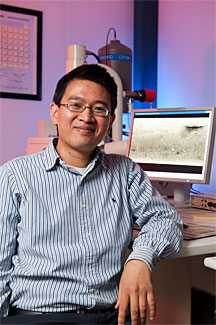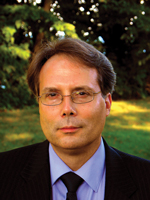By Weyman Lundquist and Carl Castro | West Coast Magnetics
Inductors are a critical component in buck and boost circuits. New developments in winding and core technologies are making it advantageous to specify buck and boost inductors at higher power levels, at higher frequencies and at higher values of ripple current. This article examines four different alternatives for boost inductor design including a gapped ferrite e-core with a new proprietary foil winding (WCM’s Shaped Foil technology), an iron powder toroid wound with solid wire, an iron/nickel blend powdered toroid with solid wire and an iron aluminum silicon powdered e-core with a helical winding. While these are clearly not the only alternatives for this type of inductor, they are the most favorable when the design objective is to develop the smallest and lowest cost alternative for medium to high power (1 kW to 100 kW) buck and boost inductors operating at high ripple values at frequencies above 10 kHz.
The choice of core requires an examination of a number of variables including loss density, saturation flux density and cost. The core material with the lowest loss density (measured in mW/cm3) is the manganese zinc ferrite, followed by the nickel iron and the Fe Al Si powdered core with the pure iron powder core having the greatest losses. The cost of a ferrite core (measured in $/cm3 of material) is slightly higher than powdered cores with high iron content, and less than powdered cores with iron as a base metal and nickel and or silicon and aluminum added for greater performance. The main disadvantage of the ferrite core is a much lower saturation flux density requiring a longer magnetic path length.
Since cost was an important factor in the present comparison not all core and winding options were considered. Amorphous, nanocrystalline and MPP cores are notably more expensive than the ferrite and powdered cores. Similarly, litz wire is significantly more expensive than solid wire and copper foil. So these materials were excluded from the present comparison.
As a reasonable approximation of an inductor that would be chosen for a medium power application, we decided to fix the inductor value at 10 uH and 55 amps of rms current. The inductor was further required to handle 65 amps of peak current without saturating. The four design approaches are described in more detail as follows.
The first approach was with a manganese zinc ferrite E core, with a gap. The material was a low loss manganese zinc material with an initial permeability of 2,000. The winding was six turns of copper foil with a cross section of 31,600 cir mils.
The winding utilized in the ferrite E core design was a new generation of WCM’s Shaped Foil technology. Developed in collaboration with the Thayer School of Engineering at Dartmouth, the technology takes advantage of the strong field in a gapped core structure to equalize the distribution of AC current with the foil winding cross section. The result is a winding that has lower DC resistance than a solid wire winding, AC resistance similar to litz wire and a low cost. It also has significantly lower losses than helical windings at high ripple values as will be shown. Improvements made to the Shaped Foil technology over the last year have been significant and a new patent application is in process.
The second approach to the design is a conventional high iron content low permeability toroid wound with solid wire. This core was wound bifilar with 10 turns of 10 awg wire. The third design used a toroid with iron and nickel wound with 13 turns of 7 awg solid wire. For these two designs the cores were sized to sustain 10 microhenries minimum at 65 amps of peak current.
 WCM does not wind helical coils, so for this technology we had to choose from available standard products. We were limited in this choice, so as a result the core chosen was slightly oversized from the perspective of energy storage capacity and current handling. Nevertheless, WCM decided to look at the cost and losses of this slightly oversized inductor. While we knew the cost would be on the high side, we were very curious what the loss curve would look like. We chose two helical windings for this core. The first had 22 turns with a copper cross section of 22,600 circular mils and the second had 12 turns with a cross section of 38,200 circular mils.
WCM does not wind helical coils, so for this technology we had to choose from available standard products. We were limited in this choice, so as a result the core chosen was slightly oversized from the perspective of energy storage capacity and current handling. Nevertheless, WCM decided to look at the cost and losses of this slightly oversized inductor. While we knew the cost would be on the high side, we were very curious what the loss curve would look like. We chose two helical windings for this core. The first had 22 turns with a copper cross section of 22,600 circular mils and the second had 12 turns with a cross section of 38,200 circular mils.
After building prototypes, WCM load tested each of the inductors to insure that they did maintain 10 uH minimum inductance under the 65 amp condition. This testing was completed using a Magna Power SL10 150 amp power supply and an Agilent 4285 LCR meter in a simple parallel circuit with two, low equivalent series resistance, 0.1 farad capacitors.
Once it was determined that the inductance minimum was met for each of the designs, losses were determined by summing core losses, AC winding losses and DC winding losses. Core losses were determined from the manufacturer’s core loss curves after determining B as a function of ripple current and frequency. DC copper losses were determined by measuring the DC resistance of each inductor using a HP 3468A to measure voltage drop in conjunction with Lambda LP-521-FM power supply for accurate readings in the milliohm range. Once the DC resistance was known, DC losses were calculated from the simulated 55 amp operating condition. AC winding resistance was measured using the Agilent 4285A and AC winding losses were then easily determined from the RMS value of the peak to peak ripple current. The total losses for each design are plotted vs. ripple current at 100 kHz and at 250 kHz in Figure 1 and Figure 2.

The materials cost was determined based on a quotation at a 1,000 piece price, direct from the manufacturer. The total volume and weight of each inductor was measured by WCM.
Total losses, cost and volume are shown in the table below at a ripple current value of 30 percent of the peak to peak ripple.

Conclusion
There is a clear path to reducing the cost of buck and boost inductors by choosing a gapped ferrite core with WCM’s shaped foil windings. This lower cost is possible because of the ability of this type of inductor to operate at higher ripple values and/or higher frequencies without excessive losses. The higher ripple operating point permits the use of a smaller inductor. Independent of ripple, the new design facilitates high current designs at frequencies of 100 kHz and up.
More specifically the ferrite with the shaped foil technology was the clear winner in this comparison. It had lower losses, lower cost, and smaller volume than any of the powdered core alternatives. While the comparison was not completely fair in that the helical coil was oversized from an energy storage perspective, the high losses of the helical coil were surprising.
It should be noted that the inductance of the ferrite core option did roll off more quickly above 65 amps than the powdered cores so the designer must be careful to anticipate this when designing for the limiting operating conditions.
 Shaped Foil Technology
Shaped Foil Technology
WCM has made a carefully controlled, direct comparison of the Shaped Foil technology to conventional windings. This work examined the price and performance of the Shaped Foil to conventional winding technologies wound on the same core. The price/performance of the Shaped Foil has been found to be a significant improvement over conventional windings for medium to high power (1 kW to 110 kW) buck and boost inductors operating at peak to peak ripple currents with a magnitude of 10 percent and higher of the DC current value. Price/performance data is plotted in Figure 3 for a 100 uH, 30 amp inductor wound on the same gapped ferrite core.
 About the Author
About the Author
Recognized as one of the leading designers in the field of magnetics, Weyman is dedicated to advancing the technology of power magnetic design. A significant portion of his award winning work has focused on predicting and reducing winding losses in power inductors and transformers. In partnership with researchers at the Thayer School of Engineering at Dartmouth, new discoveries have been made which significantly advance the understanding of power magnetics technology. These discoveries have resulted in improved magnetic devices for the power electronics industry. Weyman is an active lecturer and instructor and an avid sportsman.
For more information visit www.wcmagnetics.com



